A Perfect Weekend in Philadelphia: Complete 2 Day Itinerary
I visited Philadelphia on a solo trip after Alysha and I spent a couple of weeks on the east coast. It was our first meaningful time spent on the east coast outside of NYC, and it was an eye-opening experience in many ways.
The most jarring thing for two west coast natives was the sheer amount of history that exists on the east coast! Our cities are relatively new on the west coast, and we just don’t have the same depth and richness of American history that the east coast has.
And the bricks. Having most recently lived in San Francisco, which was leveled to the ground by an earthquake in semi recent memory, we don’t really do bricks out here.
We visited Boston in the week before arriving in Philadelphia, and I was struck by the contrast between Boston’s punk rock, question-all-authority vibes, and the more tolerant and accepting tones that show up in the history of Philadelphia. When you learn about Pennsylvania’s origin story, it actually makes a lot of sense.
Named after William Penn, a Quaker, the land that became Pennsylvania was gifted to Penn by the King of England – Charles II – to clear the crown’s debt.
This, of course, skips over the fact that the land wasn’t necessarily the king’s to give – the Lenape called this area home for thousands of years before European settlers arrived – but we aren’t going to go down that rabbit hole here.
The point is that the fact that Quakers created Pennsylvania has, in many ways, shaped the way the city is today. And, really, the country. A bunch of different ideas that made their way into the Constitution and Bill of Rights actually started with Quakers. The Quakers were able to build political influence in Philadelphia, which later became the capital of the United States of America before it moved to D.C., and you can draw a pretty direct line from Quakers in Philadelphia to the adoption of ideas like trial by jury, equal rights, and public education in America.
However, despite all of that American history, there are also stark reminders that we haven’t always lived up to the ideals that were laid out in the Declaration of Independence, which was created in Philadelphia (and SPOILER ALERT was basically wartime propaganda).
Just a block or so away from Independence Hall and the Liberty Bell is a house that was once owned by George Washington, the first president of the United States, who owned slaves. While many of his contemporaries also owned slaves, Washington never seemed to really see a problem with the practice, despite leading armies for the newly established United States, which stated in their Declaration of Independence that “all men are created equal.”
Philadelphia is full of rich history related to the American Revolution and early period of American history, which is worth spending a full day of your 2 days in Philadelphia diving into. However, it’s also home to a more modern side, with a couple of world-class art museums, and an impressive array of food and drinks, which is what your second day will be spent on.
In this Philadelphia itinerary, we’ll go through our version – really, Matt’s version – of what a perfect weekend in Philadelphia looks like to help you plan your trip, with recommendations of things to do and see based on Matt’s experience.
PS: Planning a trip to Philly? We’ve got some other super detailed travel guides you might find useful. Read our guide to figuring out where to stay in Philadelphia for our take on the best places to stay, and our guide to the best gluten free restaurants and bakeries in Philadelphia if you’re a gluten free foodie, like us.
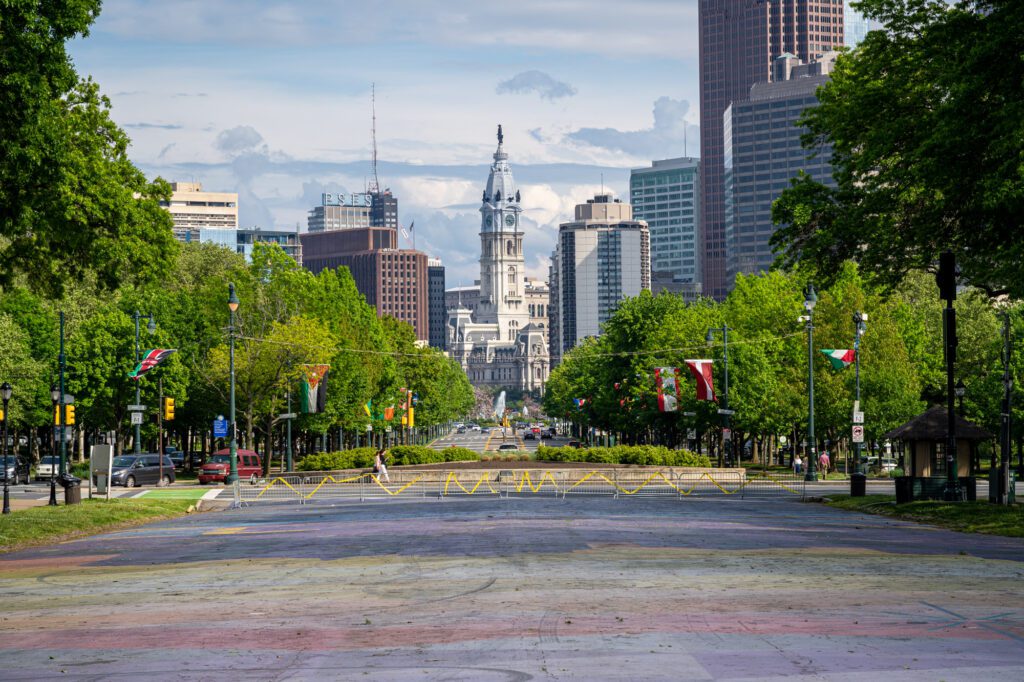
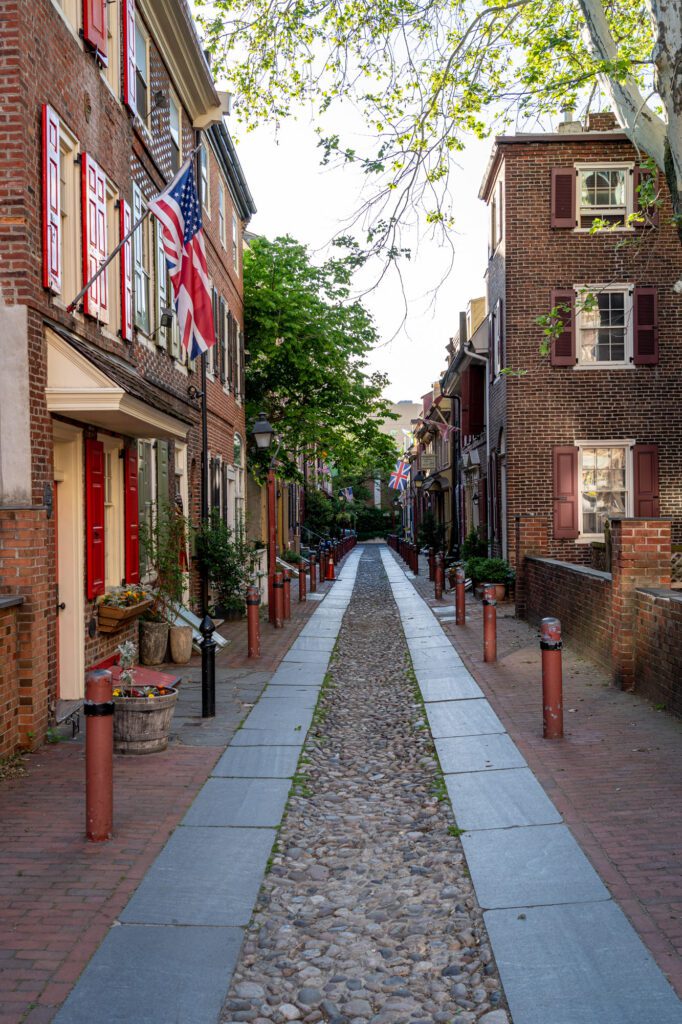
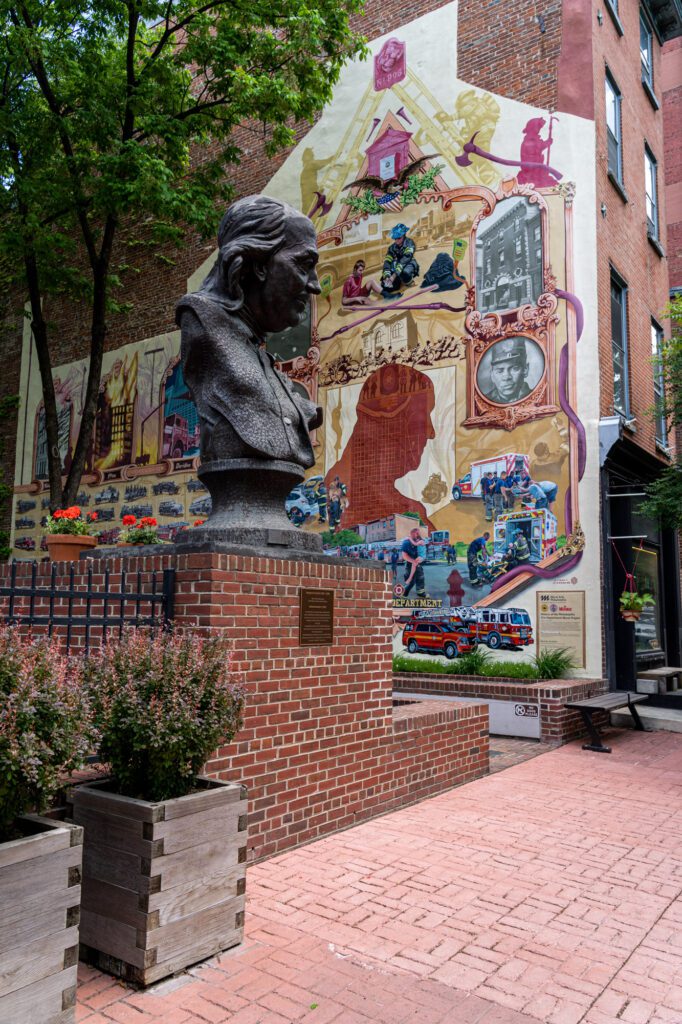
Disclaimer: Some of the links in this post, like hotel links, are affiliate links, meaning at no additional cost to you, we make a little bit of money if you click through and book. That being said, we would never recommend something to you that we don’t stand behind 100%.
Is a Weekend in Philadelphia Enough Time?
Usually, this section goes something like “no, X days is not enough time to see it all, but you can see at least the highlights!”
However, with Philadelphia, I actually think 2 days is the right amount of time to spend in the city. I was there for 4 days, and the last day especially was definitely too much time if you don’t have a car or desire to do some of the nearby day trips, like Valley Forge.
With a full 2 days in Philadelphia, you have enough time to dedicate a full day to the American history – particularly around colonial Philadelphia and the American Revolution – and a full day to the more modern side of Philadelphia, which includes some truly world-class art museums and parks.
In this Philadelphia itinerary, we’re going to assume you arrive on Friday night, and leave Sunday night, giving you two full days to explore.
Where to Stay in Philadelphia
At the end of the day, you’re probably choosing between two neighborhoods here. The center of Philadelphia – sandwiched between the Schuylkill and Delaware rivers – is relatively compact, which means there aren’t really a whole lot of options for tourists.
It comes down to whether you want to be closer to all the historical stuff (Old City), or closer to the better food and drink options (Rittenhouse Square).
PS: We have an entire guide dedicated to this topic. Read our guide to the best places to stay in Philadelphia for a lot more detail on this topic.
Rittenhouse Square
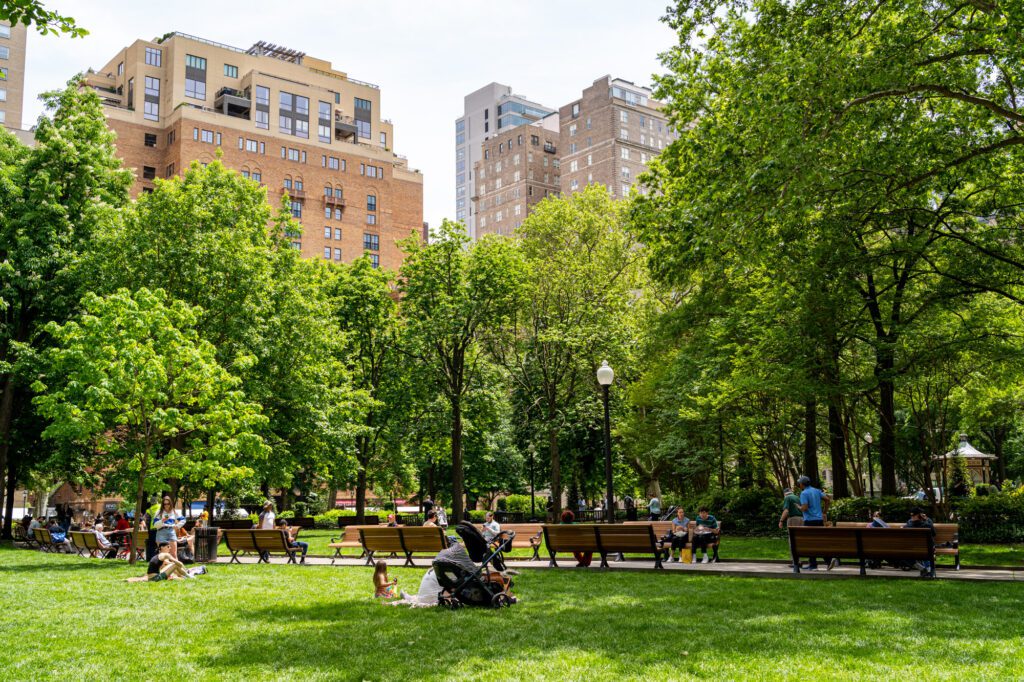
This is my overall top recommendation. I didn’t actually stay here, but after finding myself here almost every single day I was in Philadelphia, I think I would have made a different choice knowing what I know now.
The area near Rittenhouse Square is an upscale, urban part of Philadelphia on the western side of the city center near the Schuylkill River. The square itself is a green paradise in the middle of a concrete jungle, and I found myself there multiple times over the course of my trip to drink a coffee in the sun, do some people watching, and soak it all in.
The benefit of staying here is that you’re going to be right in the middle of all the best food and drinks in Philadelphia’s city center (if we’re being honest, South Philly is the true foodie paradise, which is easily accessible from here). Plus, you’ll be able to walk up to the museums from here.
The trade off is that you’re either a relatively long walk or a short metro ride from the sights in the Old City.
Roost Rittenhouse Square is THE place to stay if you’re looking for a stylish, spacious apartment with amenities similar to a boutique hotel.
There are also two stylish and affordable hotels here – the Hyatt Centric and the Motto by Hilton.
Old City: Historic and Charming
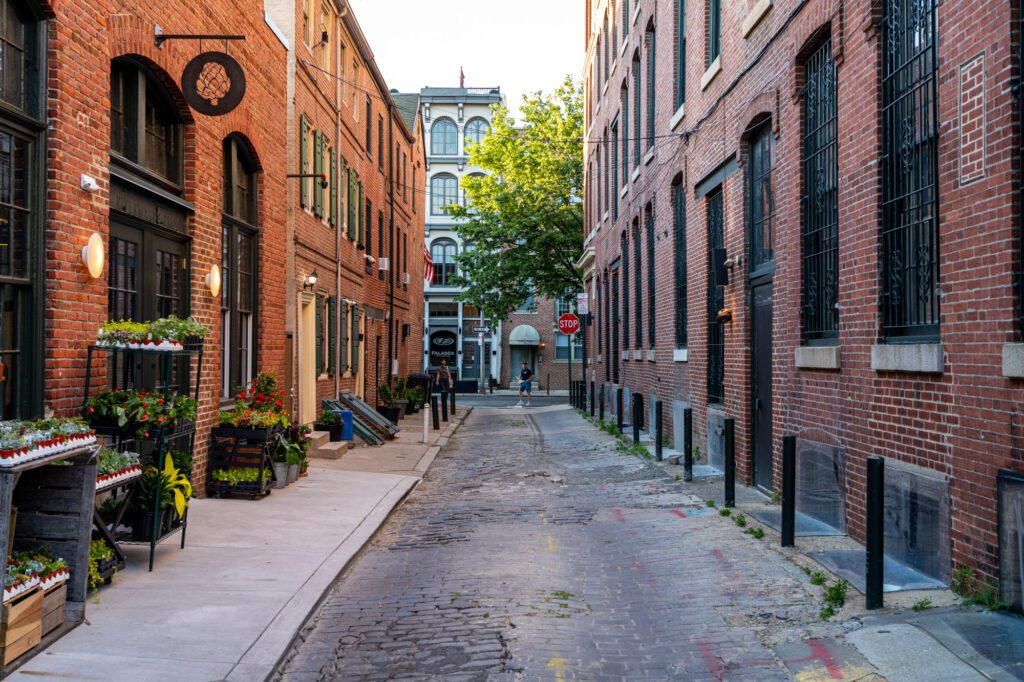
If you’re looking to stay in the room where it happened, as Lin Manuel Miranda’s Hamilton might say, this is it.
I chose to stay in Old City, which is the site of the original city of Philadelphia dating back to the 17th Century. Perched on the Delaware River, this part of the city is all red bricks, narrow cobblestone lanes, and important historical sites. It went through a period of revitalization recently, after globalization moved many of the industrial jobs elsewhere.
Over the past couple of decades, it has become a vibrant community of artists, with studios, small businesses, and bars and restaurants moving in to serve the community.
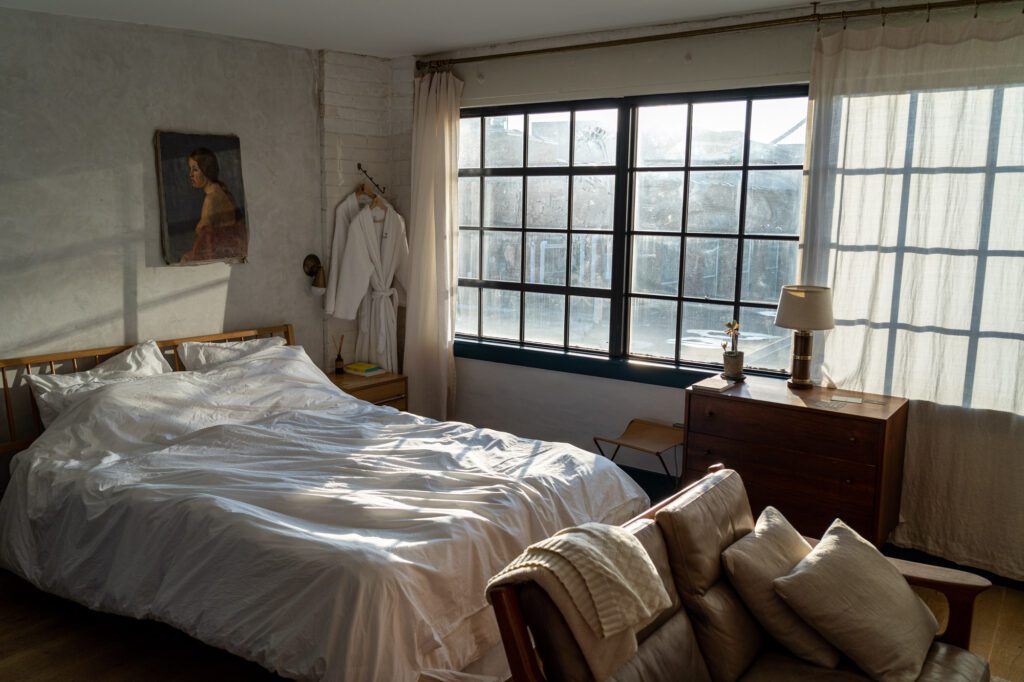
I stayed at Lokal Old City, a small collection of impeccably designed and thought-out apartments in the heart of Old City. Just blocks from Independence Hall and the Liberty Bell, I loved my apartment, the Ben, a studio on the top floor with tons of natural light. The bed and sheets might have been the most comfortable I’ve slept on in a hotel, no joke.
You know when you rent an apartment and it has a kitchen, but it’s not stocked with anything you might actually need to cook?
This was not that. It had everything, from tea and coffee to a huge variety of spices, along with pots, pans, and cookware. On my first night, I made a delicious cacio e pepe, a simple Roman pasta dish that we love, and the kitchen had everything I needed – even a cheese grater!
They only have six apartments, ranging from studios to two bedrooms, and all have a full kitchen.
If you’re looking for more of a traditional hotel experience, look at the Kimpton Monaco, which is kitty-corner from Independence Hall.
The downside of Old City is that most of the city’s most interesting food and drinks are a ways away – about 30 minutes on foot – towards Rittenhouse Square.
A Picture-Perfect Weekend in Philadelphia: A Complete 2 Day Philadelphia Itinerary
And now, let’s get into exactly how to spend your time while you’re in Philadelphia.
My version of a weekend trip to Philadelphia involves a little bit of learning, a little bit of eating and drinking, and a lot of walking. There are some great museums in Philadelphia, and I’d recommend only tackling, at most, a museum per day. That means you’re going to have to pick and choose which to focus on. Don’t worry, I have an opinion on that.
Day 1: Old City, the American Revolution, and a Philly Cheesesteak
On your first day in Philadelphia, spend the day in Old City, which is where all of the Colonial and Revolutionary history is found.
Coffee at Menagerie
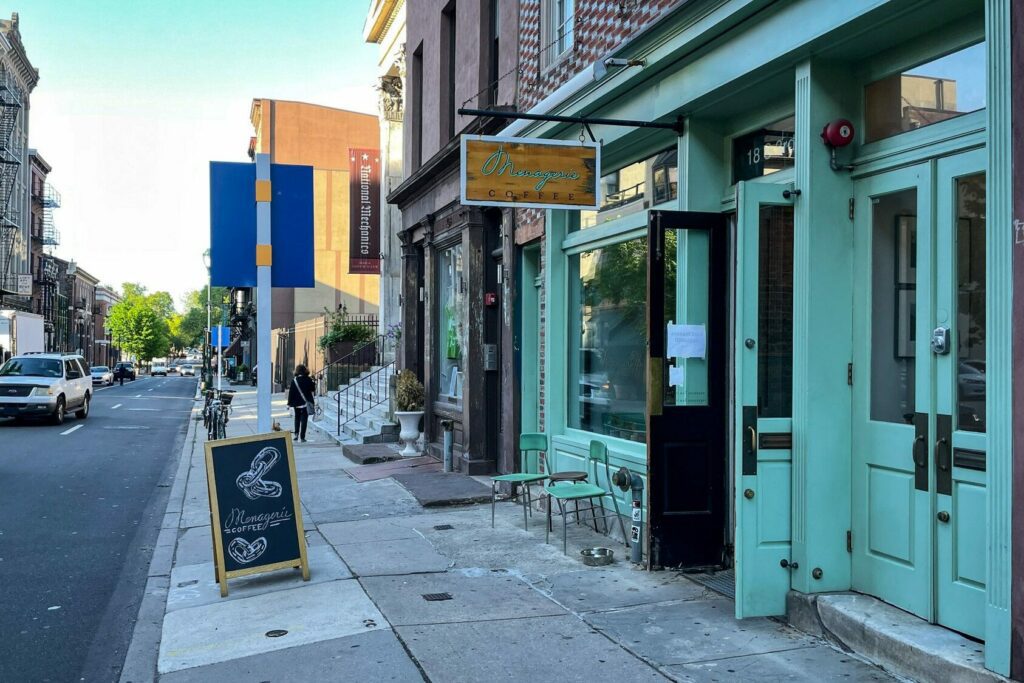
Located on S. 3rd Street, which was the same street that my hotel was on, Menagerie quickly rose to the top of my list of coffee shops to hit while I was in Philadelphia. They work with a couple of roasters, including local Elixr (more on them on the morning of day 2) and Dogwood Coffee from Minnesota.
They have a rotating list of single origin coffees available as pour over, or the usual suspects of espresso drinks if you like your coffee with a little bit of milk.
The location is fantastic, situated two blocks from Independence Hall and the Liberty Bell. The perfect spot to get caffeinated before a day of learning and exploring.
For breakfast, head a few blocks northeast to Philly Style Bagels’ Old City outpost, which are known for their bagel sandwiches (that are DEFINITELY not gluten free).
The Liberty Bell at Opening
The Liberty Bell sits inside a modern glass building on the western edge of Independence Plaza. Which is different from how I pictured it – I thought it was just out in the elements, exposed to the cold, rain, sun, and heat that comes with all the seasons in Philadelphia.
It’s completely free to visit, though the line is generally long and unbearable, especially in said heat or cold.
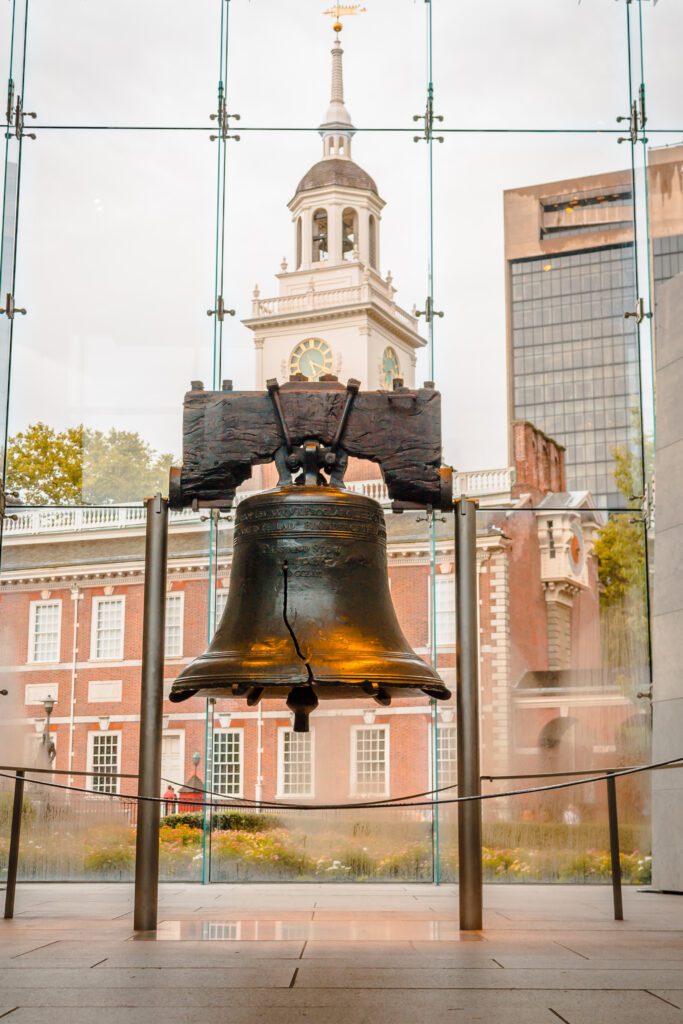
To avoid those crowds, definitely go first thing in the morning when it opens to the public at 9:00 am. There’s some information on the famous bell, like how it was made and what it represents, but the highlight here is definitely the bell itself.
However, the bell is a little underwhelming, if I’m being honest. It’s a lot smaller than I had expected, and as my walking tour guide put it, it’s objectively a poorly made bell. It has been recast multiple times, and is famously cracked in half.
It’s a much more powerful symbol than anything else. The bell itself represents the promise of and optimism that exists in the words of the Declaration of Independence, while the crack represents the failures to live up to that promise when it comes down to brass tacks and actually governing.
Over the years, that powerful symbology has been co-opted by multiple different groups in search of equal rights, including the push for Civil Rights, women’s suffrage and LGBTQ rights.
Take a Walking Tour
I have a strong bias towards taking walking tours with local guides for two main reasons.
First, because in a lot of places with lots of history, you’re often put in the position of having to imagine what things looked like at the time of the period you’re learning about. That is much, much easier to do with a guide who can help bring the history to life with anecdotes and facts along the way.
At the end of the day, the main sights in Philadelphia are really just brick buildings. It’s those stories that make them important, and you’re often going to miss those stories by just reading the signage.
Second, the guide is going to bring a level of local knowledge – how to get around, the best spots for cheesesteak, the coolest museums – and a perspective that you aren’t going to get elsewhere.
For example, my guide had strong opinions on the best Philly Cheesesteak in town, which led me to skip Pat’s and Geno’s (which are built for tourists) and pointed me in the direction of Jim’s instead.
Another example would be talking me into visiting the Museum of the American Revolution, which I was contemplating skipping until my guide started waxing poetic about how well done it is (for the record, I agree).
I chose this walking tour, and it was strictly okay (I think the guide was having an off day). I’d probably recommend a different tour – like this one run by a local company, or this tour run by an architect who has lived in Philly for decades.
Your tour will cover most of the main sights, including the Betsy Ross House and Elfreth’s Alley. But you will likely not be going into places like the Liberty Bell and the Museum of the American Revolution, which is why we’ve broken those out as separate stops.
Lunch at Bourse Market
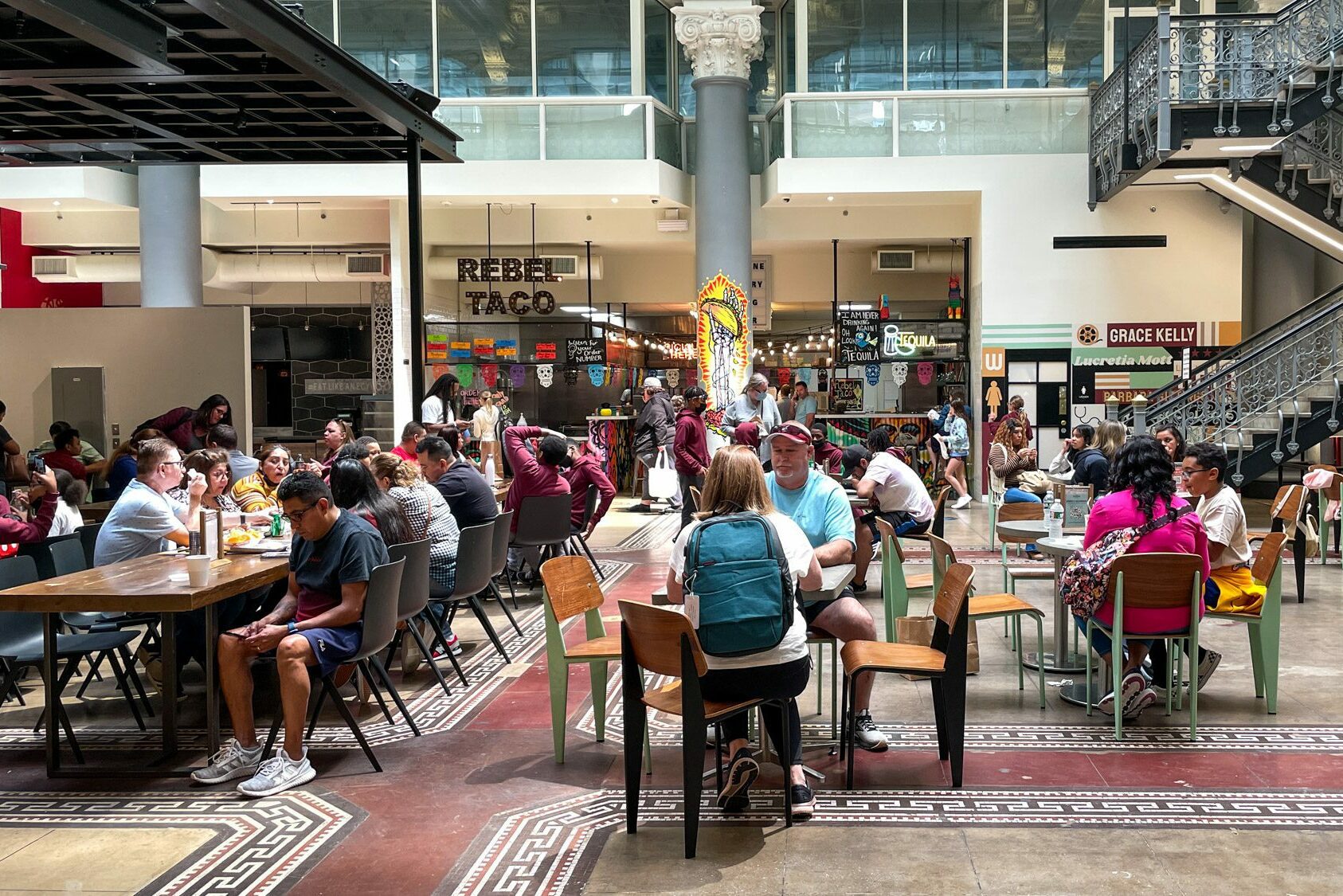
For lunch, stop by the less famous of Philadelphia’s two prominent food halls, The Bourse. Don’t worry, you’ll get to the more famous Reading Terminal Market tomorrow for lunch!
The Bourse is a modern food hall – which means more trendy restaurants than Reading – in a historical, 125 year old building in the heart of Old City. It’s a place for smaller food brands that can’t quite afford a restaurant to test out their concepts, which means you’re going to get more innovation and more interesting food offerings here.
Sprinkled in alongside the food spots are a few cool artsy stands. I liked Art Star which had fun prints, totes, mugs, and other potential gifts or souvenirs.
The other nice part about eating lunch here is that there are a ton of different options – pizza, cheesesteak, tacos, poke, the list goes on!
When I was there, there were a lot of empty stalls, so I hope they’re able to bring in some new vendors to fill them as things continue to pick back up!
The Museum of the American Revolution
Like I mentioned above, I was on the fence about visiting the Museum of the American Revolution until the guide for my walking tour basically said if you do one museum, this should be it.
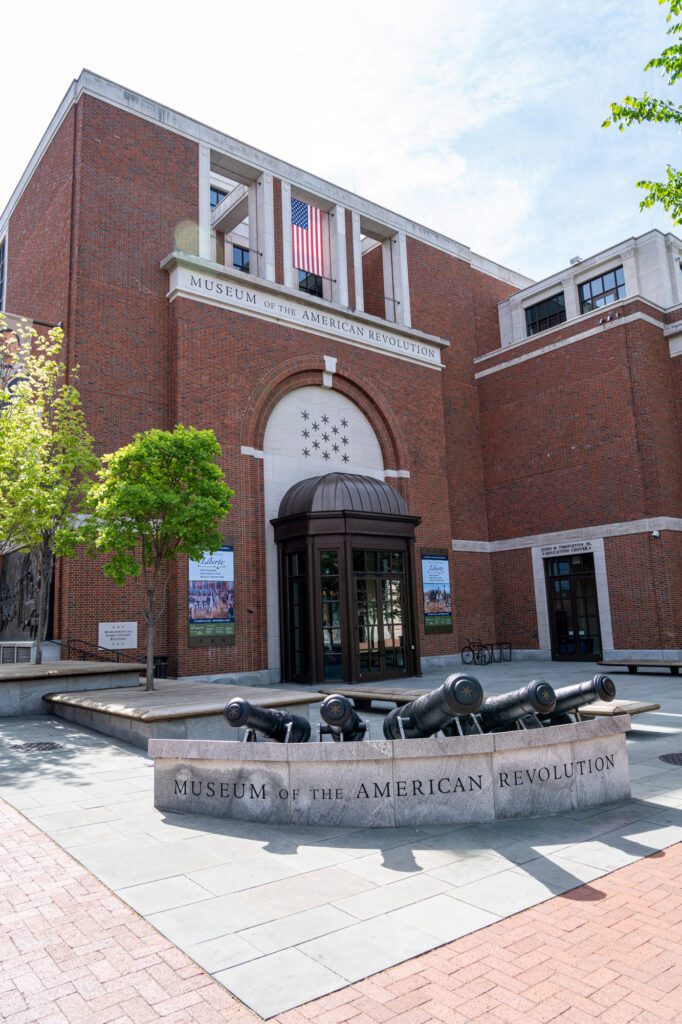
The two things that I think this museum does really well are bringing the history to life through first person accounts (they have a lot of diaries from privates and regular people) and presenting a fair assessment of the American experiment, and its strengths and weaknesses.
On the first point, the museum takes you through the history, starting with the pre-revolution period where the British Crown levied taxes that the colonists deemed unfair, through the post-revolution period where the process of governing began.
They use a variety of mediums – charts, maps, videos, and other interactive displays – to tell the story, and I thought it was well done, helping me learn things I had never heard before, and see things from a slightly different perspective.
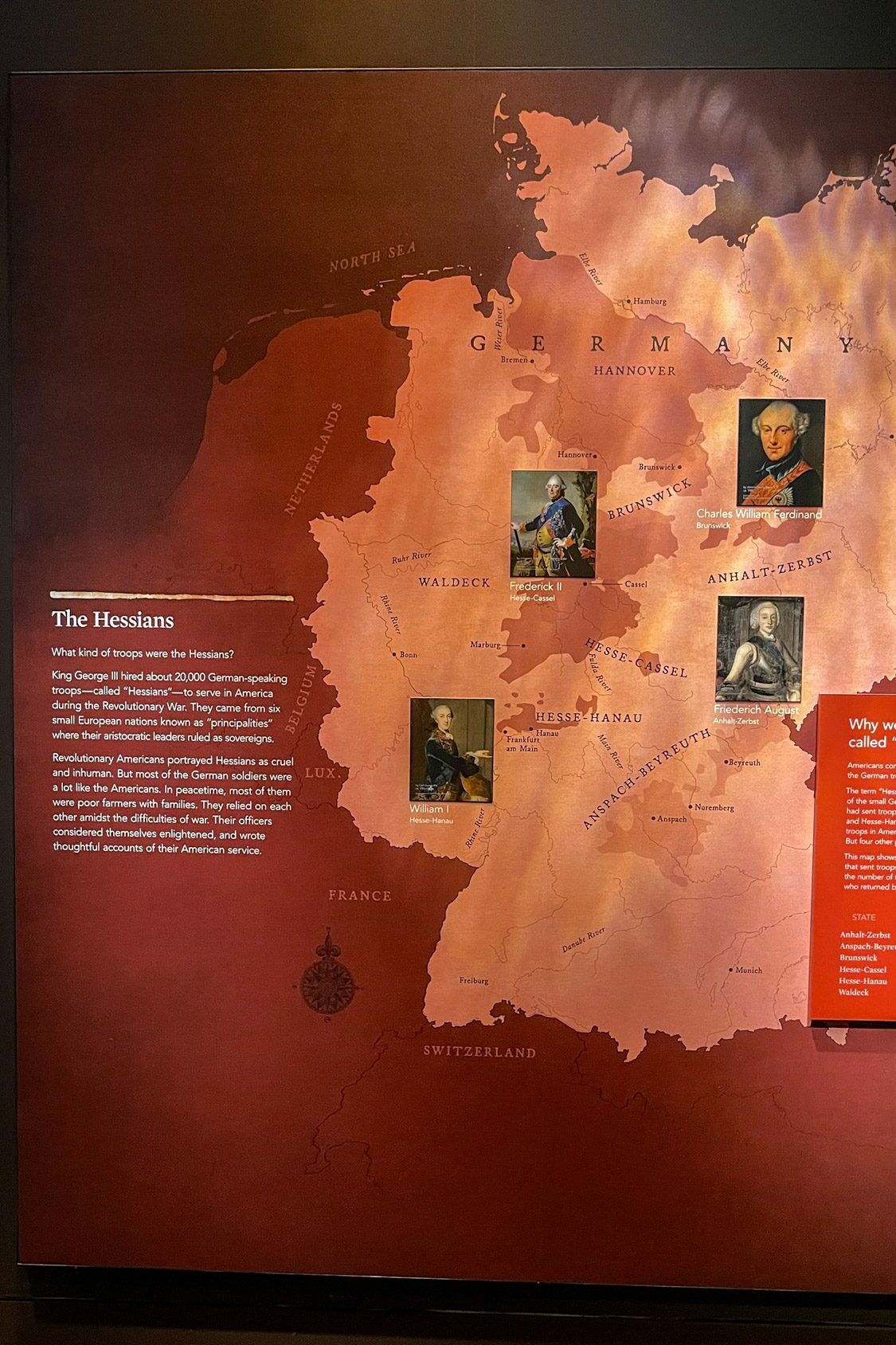
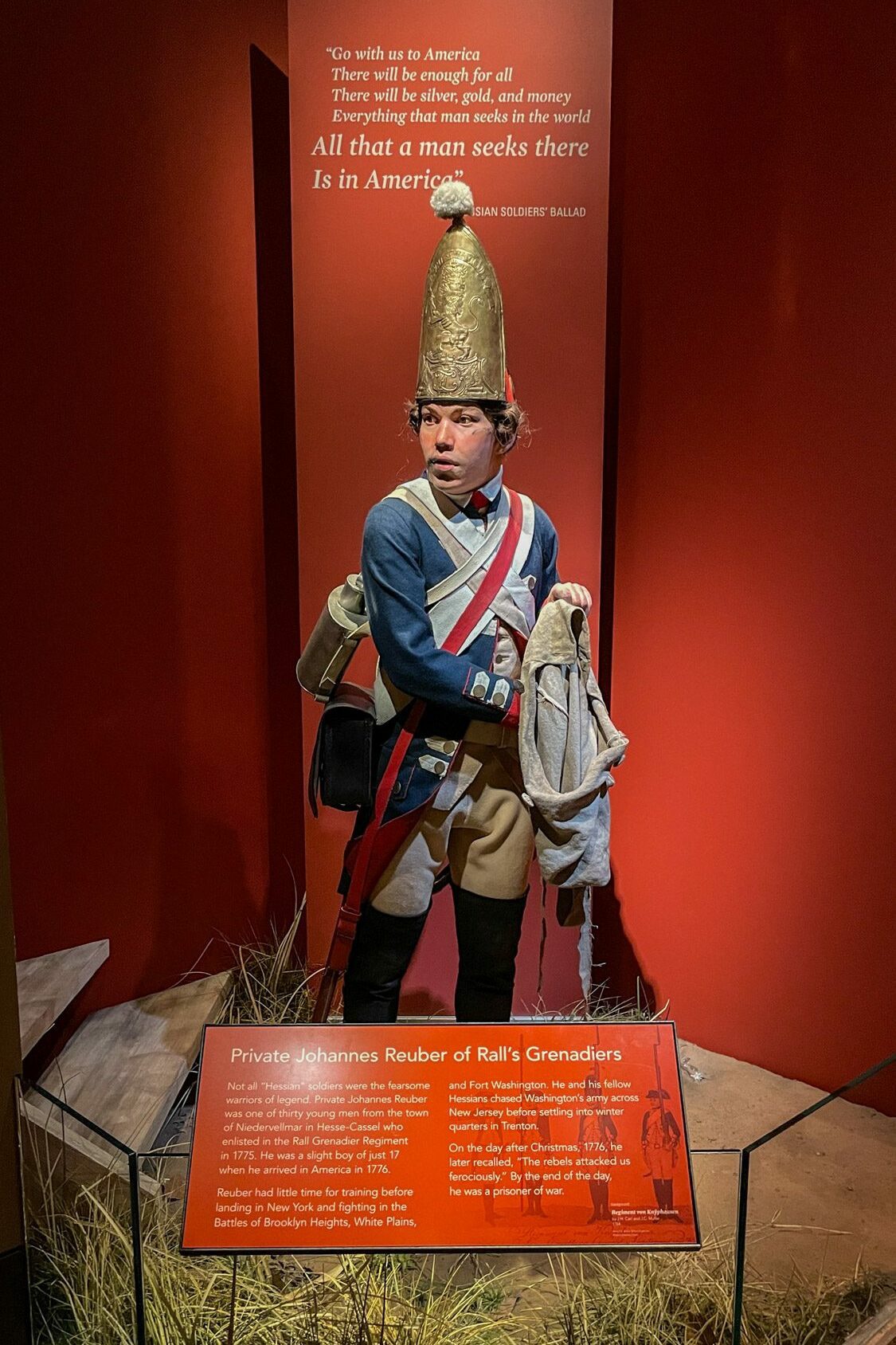
On the second point, the museum isn’t just presenting America as an infallible hero. On the contrary, there are several points in the narrative where it points out where the colonies fell short of the ideals they expressed in the Declaration of Independence (mainly the “all men are created equal” part).
Here are the basic components of the museum – it’ll take you somewhere around two or three hours to do it all properly. There’s a useful audioguide, too, so bring your headphones.
- The Opening Video: A quick 10 minute video that sets the stage for your visit, giving you context to prepare you for what you’re going to learn about at the museum.
- The Exhibit: This is where the meat of the museum is. You’ll start in the pre-war colonies, learn about the motivations of different actors in the saga, and get an understanding of the conditions in place to allow for war. Then, you’ll learn about the events that led up to the brink of war, and the first few years of the war, when the colonies started out strong and then began to crumble because of their lack of infrastructure and funding. Just as it is looking like it’s all going to fall apart, General Washington saves the day, pulling a string of victories in the Northeast out of his butt, which gives foreign nations like France and the Netherlands the confidence they needed to enter the war on the side of the colonies (I don’t think I ever understood how important this turning point was for the colonies).
- George Washington’s War Tent: Ultimately, I skipped this because there were about 200 small children in line, and I decided I wanted no part of that. WHAT ELSE.
Jim’s Philly Cheesesteaks & South Street
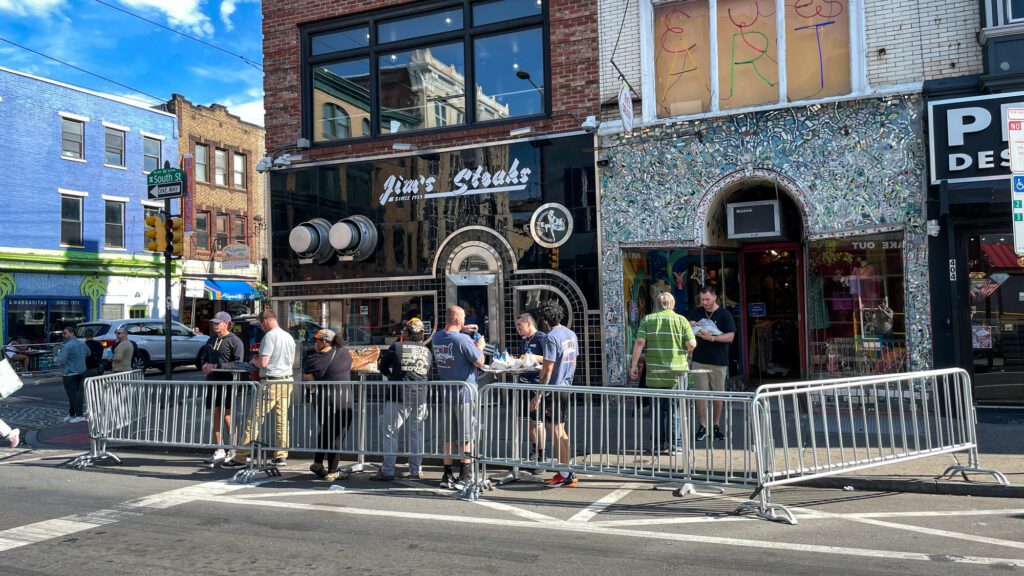
On our walking tour, two different people – the guide, and a security guard – both pointed our group in the direction of Jim’s for the best place to experience a Philly Cheesesteak.
I found it pretty amusing that our guide, who had previously recommended Jim’s, basically said “if you ask any Philly local, they probably have a different answer.” He then stopped to ask a security guard at Independence Hall where we should go to get a cheesesteak and the guy proceeded to answer “definitely Jim’s, not Pat’s or Geno’s.”
The fact that two locals gave the same answer should be a pretty good indicator. Go to Jim’s.
It’s on South Street, and it’s a half mile south of the Museum of the American Revolution. If I were you, I’d walk through Washington Square and down S 7th Street, which is a nice walk through a historic neighborhood with beautiful brick houses. Here’s a map.
Side note: I can’t actually eat a Philly cheesesteak because gluten makes my insides hurt. A lot. But that doesn’t mean you shouldn’t!
South Street is a really cool area, with lots of places to eat and drink. If you’re into hard cider, I really enjoyed Hale & True Cider (their hopped cider is great), and the pizza place across the street – Nomad Pizza – was very, very popular with locals if you’re looking for a place to have dinner.
Day 2: Exploring Modern Philadelphia
On your second day in Philadelphia, spend your time exploring the more modern side of the city, which is mainly concentrated on the western end of the city closer to the Schuylkill River.
Coffee at Elixr
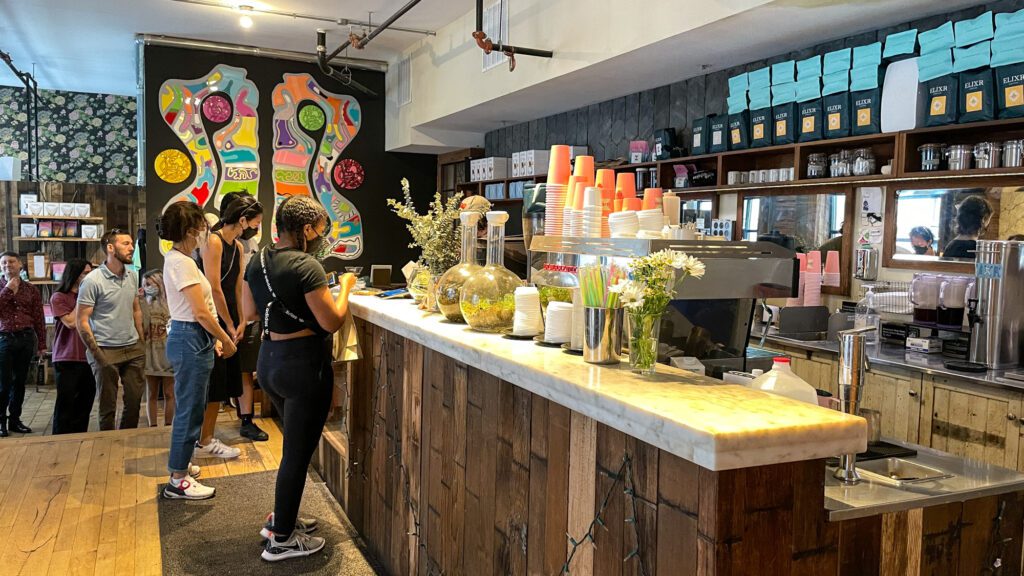
Elixr is probably my favorite coffee shop in Philadelphia (though Rally just off of South Street is a close second!) and was one of the original specialty coffee shops in the city. Their location is a few blocks east of Rittenhouse Square, and has some nice indoor seating, a few outdoor seats, and great coffee waiting for you.
Though, of course, the park is the best outdoor seating option – it’s just a couple of blocks away.
They focus on light roasts, which allows the more delicate flavors of the coffee fruit come through (versus darker roast, which papers over those flavors with smokier flavors), and is hands down my personal preference in terms of roast profile.
Even if you’re more into darker roasts, I’d recommend that you at least give their coffee a shot!
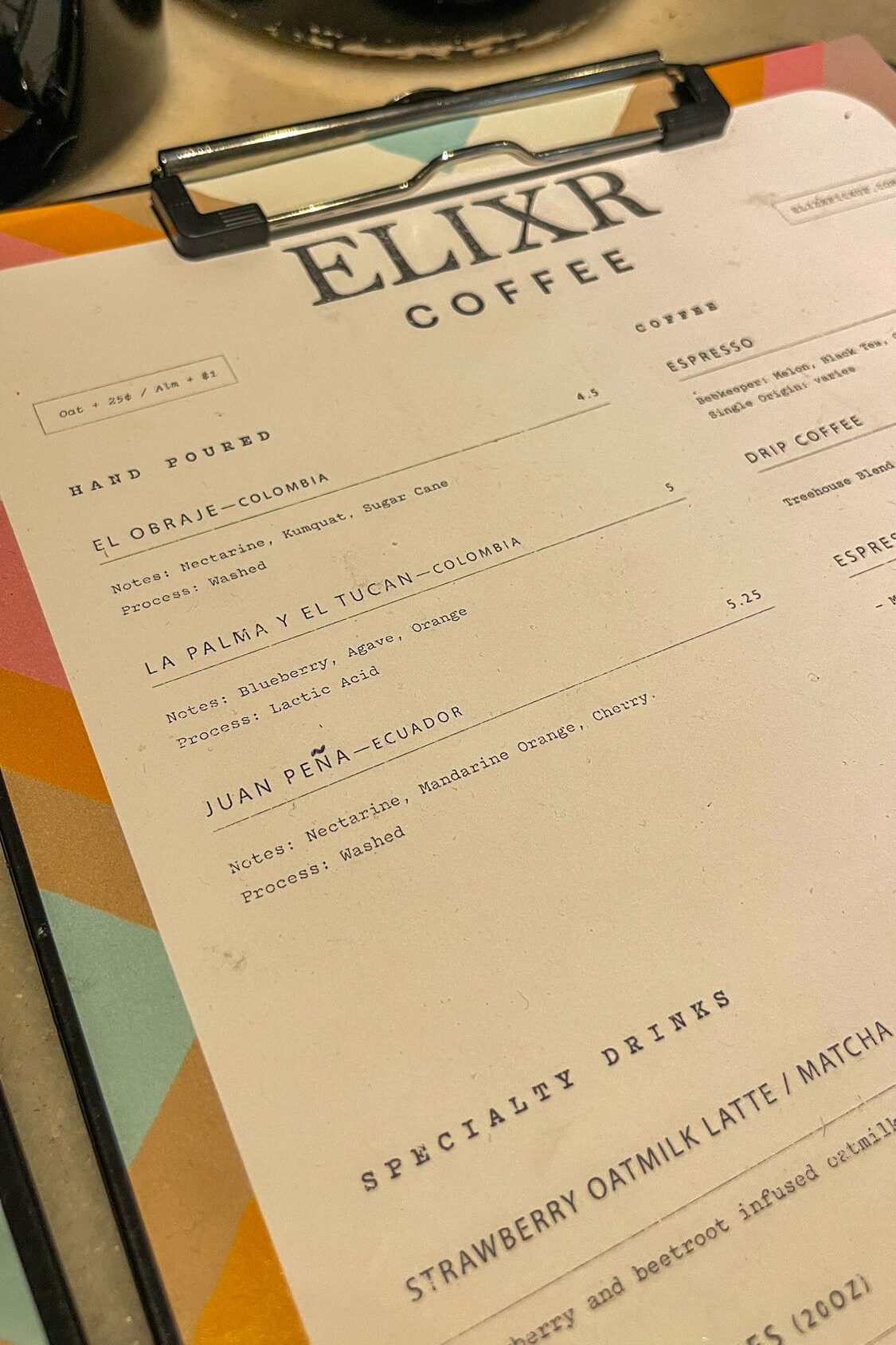
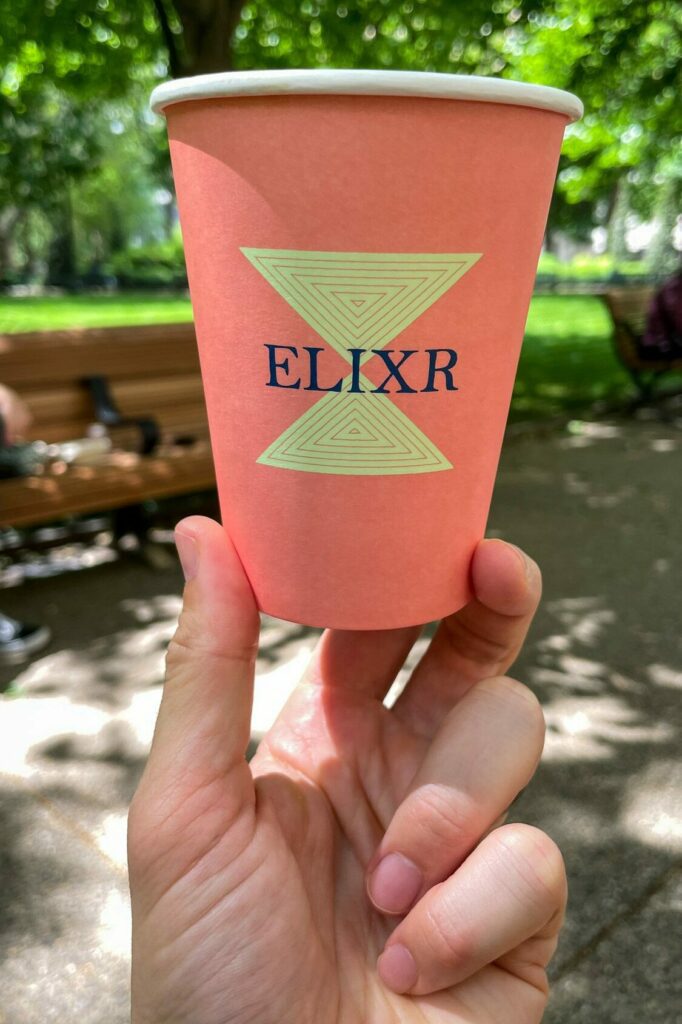
They have a couple of pour over options available, plus a full range of espresso-based drinks and some seasonal offerings as well.
Rittenhouse Square
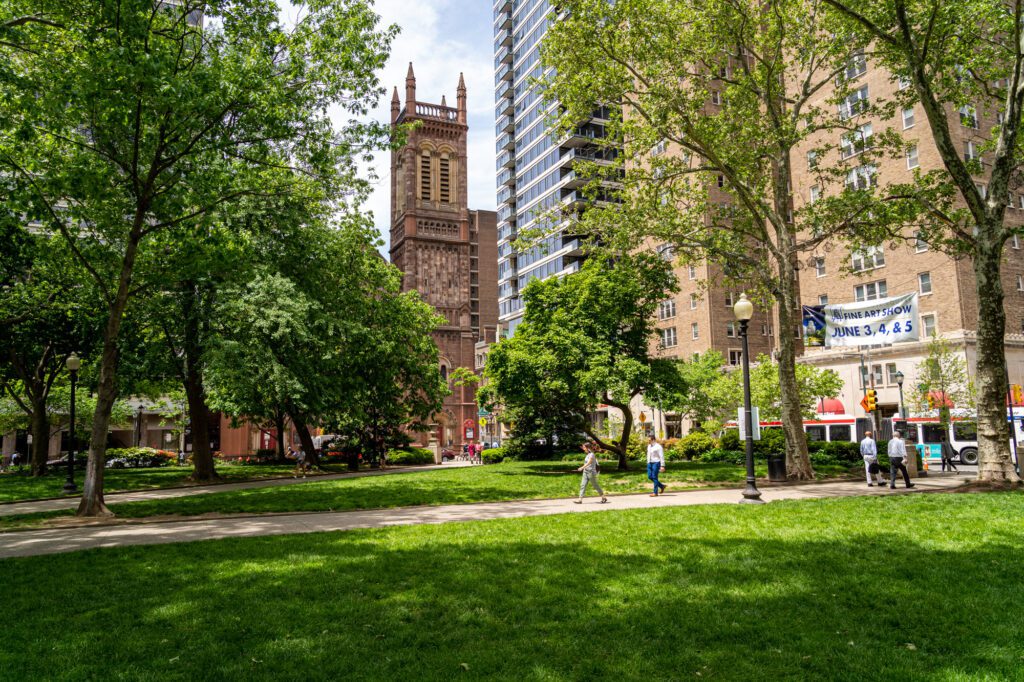
Rittenhouse Square is a public park in the middle of Philadelphia that dates back to the early plans for the city that William Penn made. At that time, it was thought to be on the outskirts of the city, though now it is very much in the middle of all the action.
I found myself here multiple times over the course of my time in the city, and it’s a lovely place for a stroll and some people watching.
The square is kind of a crossroads for the adjacent neighborhoods. West of the park towards the river is one of the most expensive neighborhoods in the country, full of residential housing. East of the park towards Center City is decidedly more commercial. The streets are lined with restaurants and shops featuring many of the hippest, most expensive brands around (think Allbirds, Urban Outfitters, and Apple).
It’s a lovely place to sit and relax, particularly when it’s sunny and Philadelphia’s residents are out and about, picnicking in the sun.
Reading Terminal for Lunch
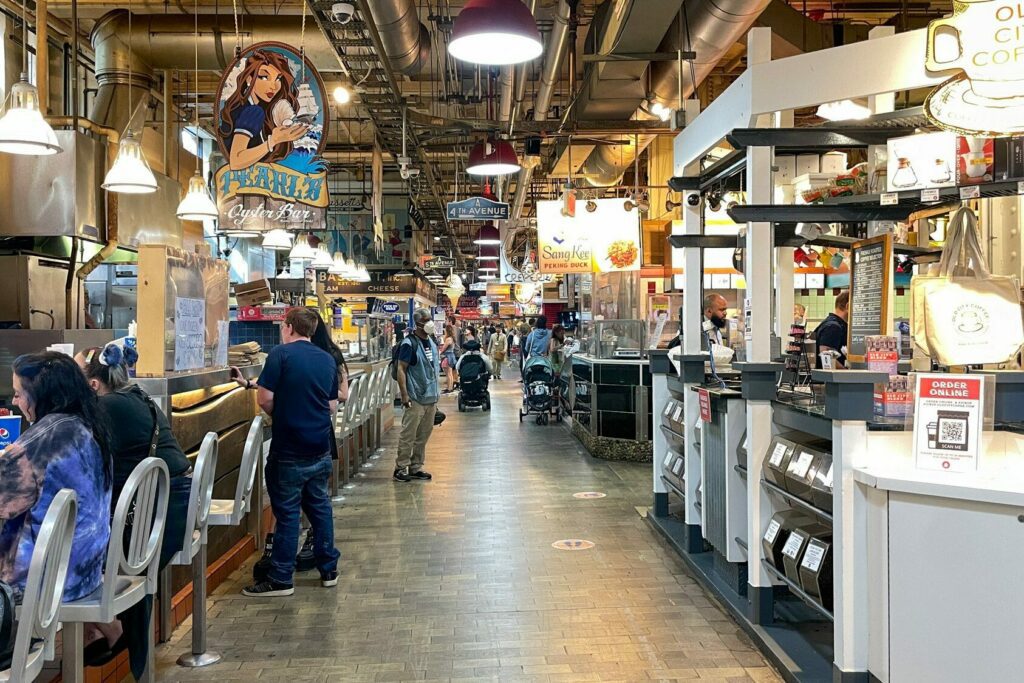
For an early lunch, head over to the more famous of Philadelphia’s food halls – Reading Terminal Market. They have a collection of more than 100 vendors, ranging from produce stands to coffee bars to cheesesteaks, donuts, and sushi.
It’s a good place to go with a group and plan on sharing a bunch of different things from different stands.
It’s largely ready-to-eat meals, which don’t really pick up until about 10:00-11:00 am (based on my experience going early and finding it pretty quiet).
The southern end of the market seemed to be more raw ingredients – a cheese shop, a charcuterie stand, a produce market – while the main section of places to grab lunch is on the northern end.
This is paradise for foodies and though I have Celiac Disease and can’t take part in most of the festivities in a place like this, I would highly recommend Fox & Son, which serves fair food like corn dogs, loaded fries, and funnel cakes that are 100% gluten free (though you’d never know it).
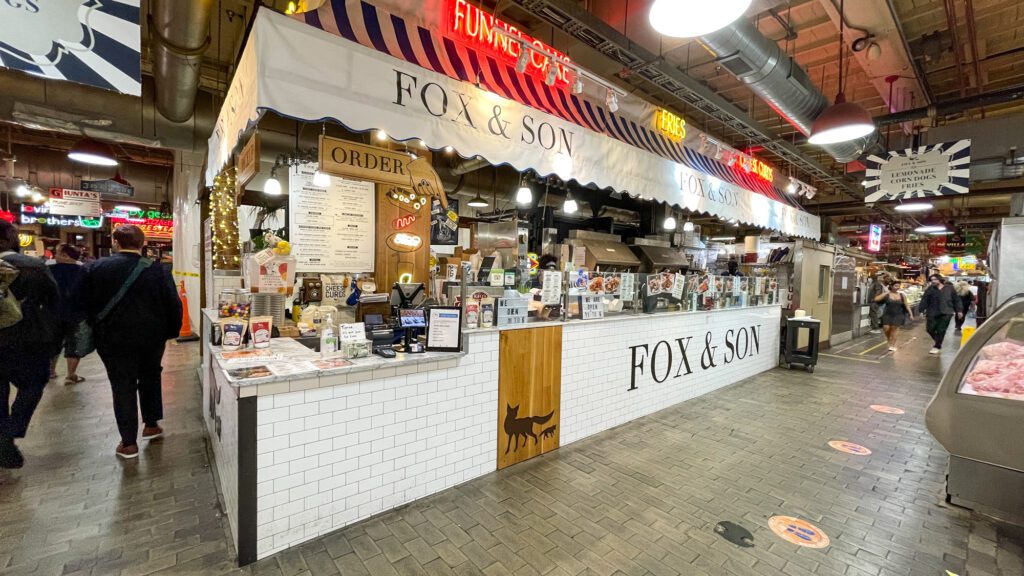
For other recommendations on what to eat at Reading Terminal Market, I’d turn here, here, and here.
Tackle An Art Museum: Choose Your Own Adventure (Rodin vs. Barnes)
There are a few art museums to choose from in Philadelphia, and I’d urge you to choose between the two French-focused museums – the Barnes Foundation, famous for its expansive collection of impressionist works, and the Rodin Museum, the biggest collection of Rodin sculptures outside of Paris.
I don’t think you should do both if you’re doing Philadelphia in 2 days, so you’re going to have to choose. Here are my thoughts on them.
The Rodin Museum
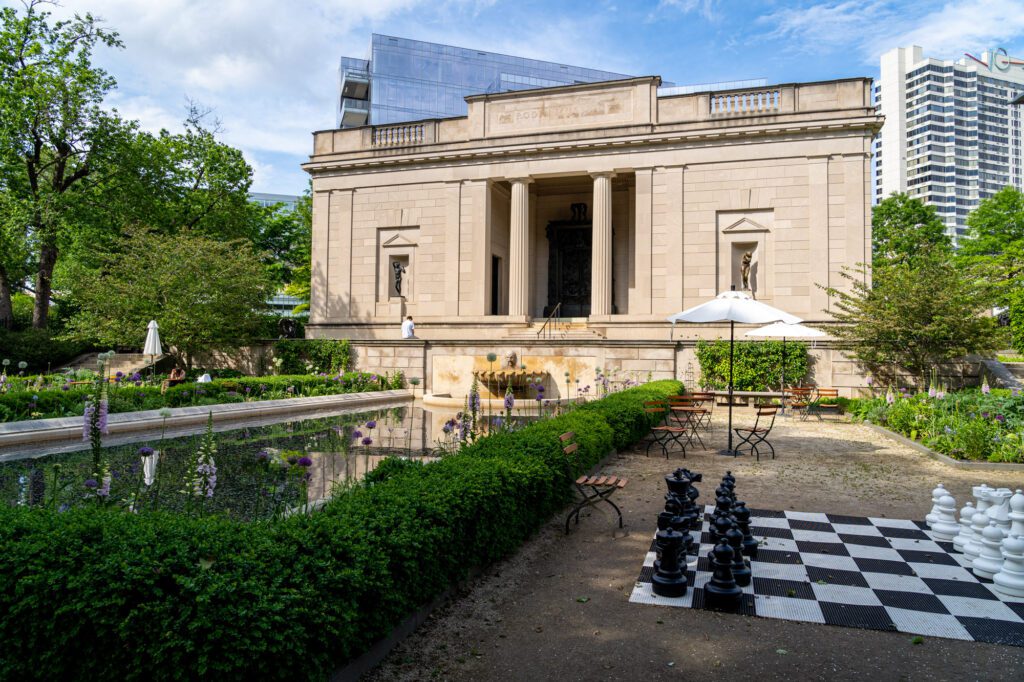
The Rodin Museum in Paris is my favorite of the city’s museums because it narrows the aperture, focusing on one man (Auguste Rodin) at one point in history, and taking you through his journey to becoming one of the most famous sculptors of all time. Compared to the Louvre, which is downright overwhelming at points, it’s a unique way to experience art.
The Rodin Museum in Philadelphia is similar to the museum in Paris – I was very surprised to see that they have their own casts of the Thinker and the Gates of Hell – and is the biggest collection of Rodin’s works outside of Paris.
The museum is operated by the nearby Philadelphia Museum of Art, and was gifted to the city in the late 1920’s by an American businessman who started collecting works by Rodin with the dream of creating a museum in Philadelphia.
It’s a relatively small museum, which means you only need to spend an hour or two to experience it properly (which is the right amount of time to spend in an art museum before my brain completely shuts down).
One thing that’s kind of cool is that on Fridays (between Memorial Day and the end of September), they host a pop-up bar in the garden out front from 4:00-8:30 pm. There are some giant chess sets, and a bunch of seating. A visit to the museum and then a drink in the garden would be a cool way to kick off your weekend in Philadelphia, if you can swing it. More information here.
Cost: Adults are $12, under 18 are free. You can get a two day ticket for the Rodin Museum and the Philadelphia Museum of Art for $25, if you want to visit both during your trip.
Hours: Friday to Monday, 10:00 am to 5:00 pm.
The Barnes Foundation
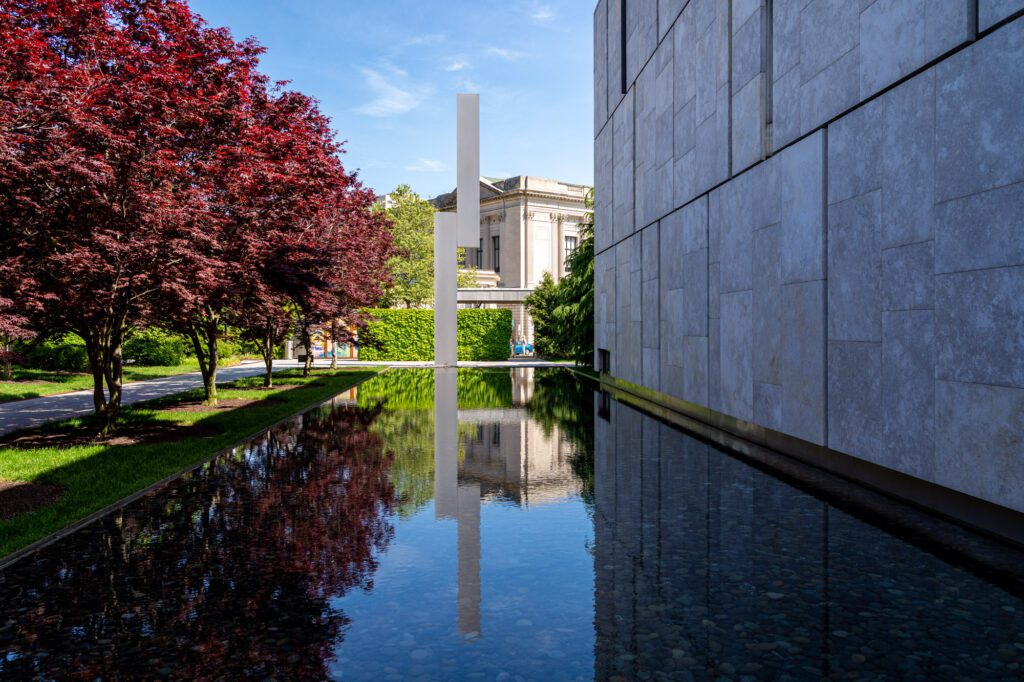
The Barnes Foundation is a private collection that was built by Albert Barnes, a businessman-turned-art-collector with a penchant for French impressionism.
Over a few decades, during which he was given a mandate by Pennsylvania to create the Barnes Foundation and turn it into a learning center for fine art, he collected $25 billion (in today’s dollars) worth of art.
This is an eclectic collection of works, mainly from French impressionists like Cézanne and Renoir, though there’s also a Van Gogh, a bunch of Picasso (many of which are surprisingly un-abstract), and even a piece from the Dutch master Bosch, whose hellish pieces I really enjoy after visiting the Prado Museum in Madrid and learning about his take on morality and religion.
The collection is small, with just a couple of floors and about eight rooms on each floor.
One thing I enjoyed was the fact that this expanded my understanding of impressionism, which I thought was all still lifes of water lillies and various fruits, to include landscapes.
Cézanne in particular was masterful at painting the French countryside in the typical impressionist style, which was a new approach that I hadn’t seen before (I must have missed it at Musée d’Orsay?).
It’s a relatively short visit – you can do it in about two hours – and I enjoyed it. They have a cool digital guide that uses technology to recognize what painting you took a picture of and give you information on your phone – there’s no signage in the museum itself (so bring your phone!).
Cost: $25 for adults, teenagers and college students (with ID) are $5, and children under 12 are free.
Hours: Thursday to Monday, 11:00 am to 5:00 pm
Walk to the Rocky Statue + Philadelphia Art Museum
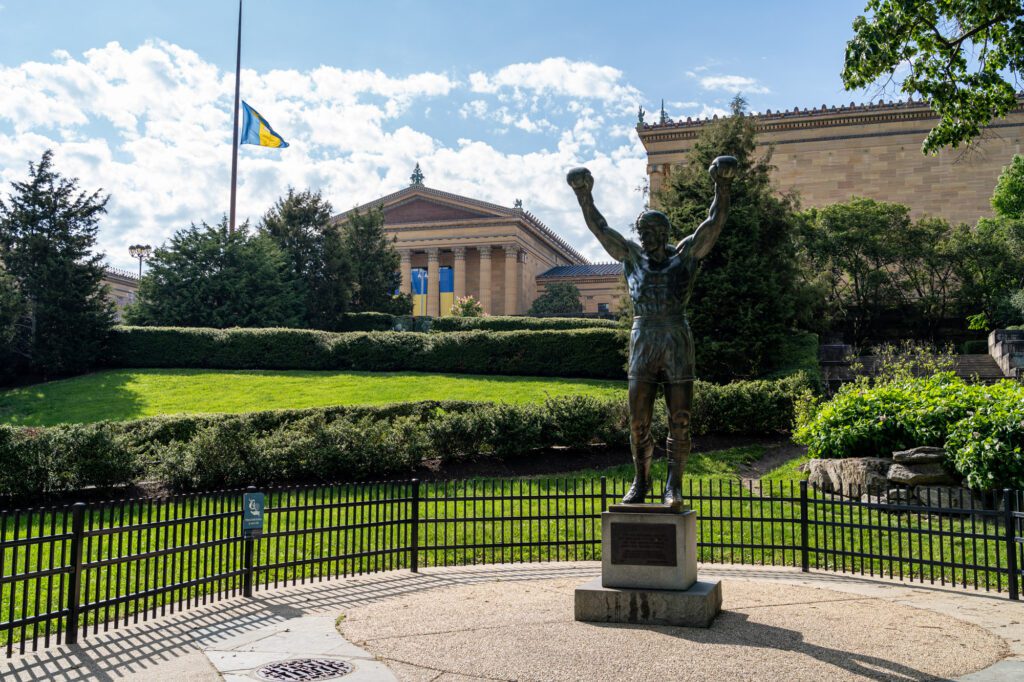
While I wouldn’t recommend spending your limited time visiting the Philadelphia Museum of Art, mainly because I enjoy smaller, more focused collections when I have limited time to work with, I would recommend walking over there for a few reasons.
First, the Rocky statue. Everyone wants to see the Rocky statue! At one point, they moved it away because it didn’t fit with the vibe of the museum, and ended up moving it back because so many people were asking about it and why it wasn’t sitting at the top of the famous stairs from the movie. So they moved it to the base of the stairs, tucked away in a little green space to the right of the stairs.
Second, the views back towards City Hall and downtown Philadelphia are great.
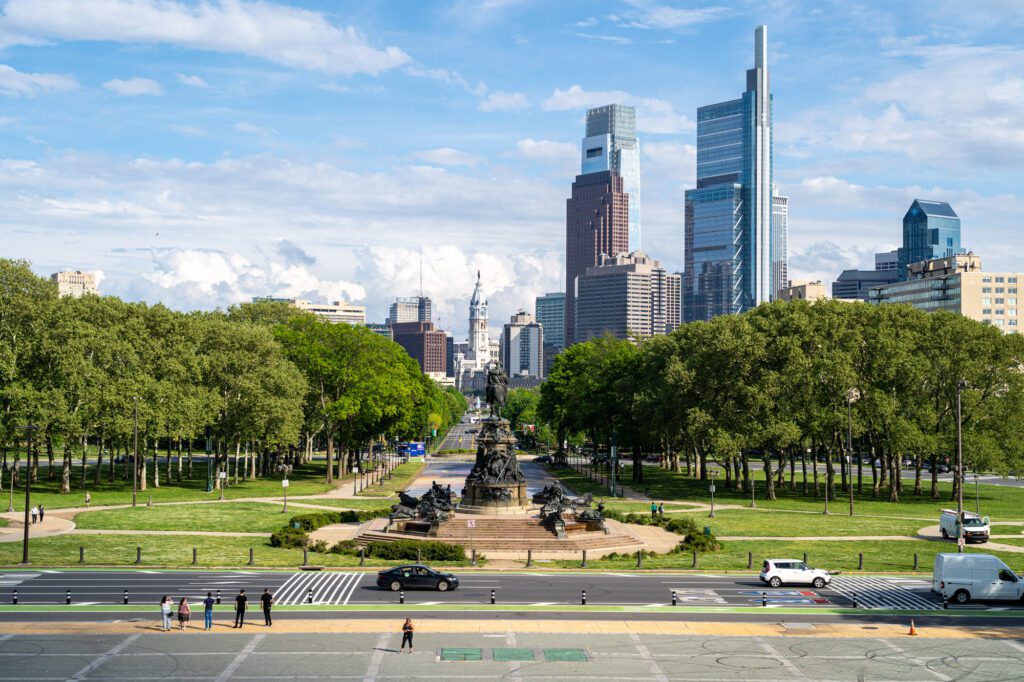
Last, the Washington Monument fountain on the other side of the road from the stairs leading up to the museum.
It depicts George Washington on his horse on the top level, with two other levels. It’s a cool monument to look at thanks to the intricate engravings and huge animal statues on the bottom level… as long as you ignore the darker history lurking beneath the surface.
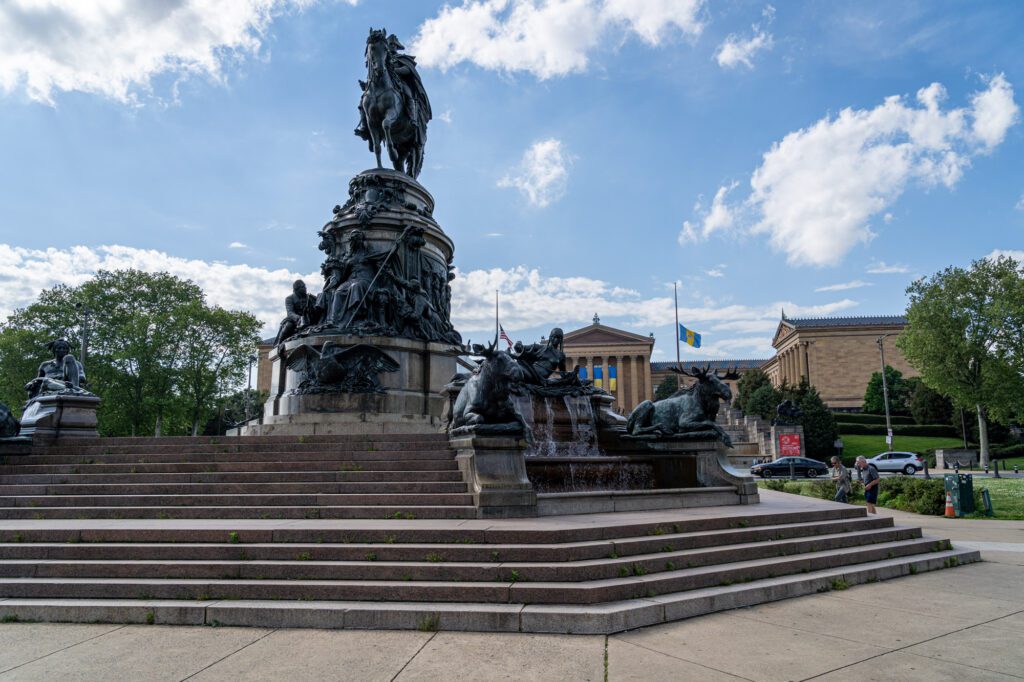
Washington, like many of his contemporaries, slaughtered indigenous inhabitants (and stole their land, destroyed their towns, and completely shattered their way of life) of what would later become the United States of America, particularly the Iriquois who had sided with the British.
Here’s a good read on the topic (it starts with discussing recent protests in Philadelphia, and the section at the bottom about Washington is the part I found particularly interesting).
Ultimately, like many of the other pieces of American history in Philadelphia, it’s yet another reminder that America is, and never has been, perfect. And neither are the heroes we read about in history books growing up in America.
And, for me, that’s okay. As long as we can have an open and honest conversation about that, and we continue moving forward and learning from past mistakes.
Dinner and Drinks in Fishtown
This is one of the few times over the course of this itinerary that probably requires a ride on public transportation or a taxi to get to.
Fishtown is an area that’s north of Old City, and it’s currently home to an up-and-coming food and drink scene. It’s also a gentrification hotspot in Philadelphia, and the neighborhood is undergoing a major change, similar to the ones we’ve seen in places like Brooklyn (in New York City), the Mission District (in San Francisco), and Capitol Hill (in Seattle).
We’re not going to solve gentrification here – the displacement of poorer residents is a reality that has happened in virtually every big city, and is driven by a confluence of different challenges all coming together. However, it’s worth being aware of what’s happening in this area when you visit, as you can’t miss the signs that it’s happening.
If you’re interested, here’s a good read on gentrification in Philadelphia.
With that out of the way, the main reason to come to Fishtown as a tourist with limited time is pretty simple: the food (and drinks). This is the part of the city that’s packed with all of the trendy hotspots that food writers in Philadelphia are raving about.
Again, it’s worth noting here that I, Matt, have Celiac Disease, and thus I haven’t been able to partake in most of the food scene up this direction.
However, that certainly does not mean that you shouldn’t!
I’m going to give you a few places that caught my eye, and then link you to a few places where you can find more information on where the foodies recommend eating in Fishtown.
For pizza, head to Eeva. Funny enough, I actually found myself here early in the morning (we’re talking before 8:00 am) because they share a space with ReAnimator Coffee (which is also good). They were firing up the wood-fired pizza ovens and getting ready for a busy day of service.
Another good, more famous option for pizza nearby is Pizzeria Beddia, which has won all sorts of awards over the years and was one of the original foodie entrants into the Fishtown area.
For drinks, this area is packed with bars serving everything from Bud Light, to cider, to fancy cocktails, to locally brewed beer, and just about everything in between. Check out Evil Genius or Human Robot for beer, Original XIII for locally made cider (and some interesting beers on tap), and R&D for (expensive) fancy cocktails.
For more recommendations, check out this post on Reddit – I’ve found that Reddit has some of the best real recommendations for food and drinks, rather than a simple list of all the possible restaurant options.
What to Do with One Day in Philadelphia
If you have one day in Philadelphia, I’d get an early start and do the Liberty Bell at opening.
Then, I’d do the walking tour (which means you’ll skip the Museum of the American Revolution, sadly) and get lunch at Reading Terminal Market.
Choose between the two museums – Rodin or the Barnes Foundation – and then head to Rittenhouse Square.
From there, head to Jim’s for a classic Philly cheesesteak, and end your day down on South Street at one of the many bars lining the bustling thoroughfare.
Getting Around Philadelphia
For the most part, you should plan on exploring Philadelphia on foot, though there is a subway and bus system that will also help you cover more ground.
On Foot
Philadelphia is an extremely walkable city. It’s basically entirely flat between the two rivers that form the eastern and western borders of the city center, and it only takes about 45 minutes to walk from one river to the other. Not that you’ll really ever be doing that on this itinerary anyway, but compared to cities on the west coast, it’s tiny.
Or, to put it in east coast terms, on a scale from NYC to Boston, it’s far more similar to Boston in terms of compactness and walkability.
I’d recommend doing as much walking as you can while you’re in Philadelphia. The itinerary above is organized in a way that means you should be able to tackle the entire thing without needing a taxi or public transportation, if you’re up for walking.
Public Transportation
Within the city center, your two options are going to be the subway or bus. I like taking public transportation when I travel, and got a three day unlimited pass for my trip.
I spent seven years using public transportation to get to and from work across the Bay in San Francisco. Keeping in mind that I’m a sort of public transit enthusiast – a barista at a coffee shop in London laughed at me when my answer to “what’s your favorite thing about London?” was “the Tube” – I really did not like taking public transit in Philadelphia.
Let’s start with buses, which are probably the best option for going north / south to places like Fishtown and South Philadelphia. I’m not sure why, but every single bus I took in Philadelphia was packed. At all hours. Going in all directions. Maybe they need to run more buses to keep up with demand? It was not a particularly pleasant experience.
The subway was – again, this is coming from someone who regularly rides BART in the Bay Area and loves the subway in NYC (which is a polarizing opinion, at least to some people we met in suburban New Jersey who tried to convince me that I was going to die if I stepped foot on the NYC subway) – very dirty, especially the City Hall station, which you’d think would be one of the stations with the best upkeep.
Turns out, the public transportation system in Philadelphia receives far less funding than similar sized systems in other cities, and is chronically underfunded to the point that they’ve been putting off repairs for years that are adding up and will require an investment of more than double the average annual budget to repair.
This is a great read about the situation and its effects on local residents. Spoiler: the biggest, most negative impact is on the poorest and most vulnerable citizens of Philadelphia.
At the end of the day, you really don’t need to use public transportation for this 2 day Philadelphia itinerary. The city center is compact enough to walk basically everywhere, and for the one-off trip that might pop up, I’d recommend taking a Lyft or taxi.
Getting to Philadelphia
If you’re coming to Philadelphia from a major city on the eastern seaboard, we’d recommend taking Amtrak to go between the cities. It’s far less stressful and, in many cases, cheaper and faster than flying.
If you’re coming from somewhere else, then flying is going to be your best bet.
Taking Amtrak
First of all, train travel is the best. We spent three months in Europe last year after a couple of years spent driving everywhere and very occasionally flying, and being in Europe made us fall in love with traveling by train all over again.
It’s, by far, our favorite way to get around, and we wish there were more train options on the west coast. Given the distances between cities, though, it makes sense why that doesn’t really exist.
There are a couple of Amtrak lines that connect Philadelphia to other major cities up and down the eastern seaboard, including a high-speed line between NYC and Philadelphia that makes the journey in about an hour and 20 minutes.
I took Amtrak from New York City, and it was one of the easiest travel days I’ve ever had.
Because of the nature of the stretch of tracks between New York and Philadelphia, the high-speed line only really saves you 10 minutes or so, which means the more affordable Northeast Regional line is a better choice for travel between NYC and Philly.
If you’re coming from further afield – Boston or Washington D.C. for example – the faster (and more expensive) Acela Trains might be a better choice if time is a limiting factor. It saves you about an hour and 15 minutes between Boston and Philly (it’s a five hour journey in total) and 30 minutes between D.C. and Philly.
It’s also worth noting that the further in advance you buy your tickets, the cheaper the ticket is likely to be. If you know your dates, go ahead and buy them now!
From Elsewhere
If you’re coming from somewhere that’s not on the eastern seaboard, you’re likely going to be flying into Philadelphia International Airport (PHL).
To get from the airport to the city center, you can take the SEPTA Airport line, which only takes about 20-25 minutes. It runs every 30 minutes (hourly on weekends) from 4:00 am to 11:00 pm (from 5:00 am on weekends). You’ll need to buy a SEPTA Key Card from the kiosks at the airport, and the ride (called a “Quick Trip”) will cost $6.75. You can pay with cash on board the train, but it costs $8.
More Northeast USA Travel Guides
If you like this guide, you won’t want to miss our other travel guides for the northeast!
New York City
- 3 Days in New York City: A Perfect Long Weekend in NYC
- Where to Stay in New York City: The Best Areas + Hotels
- Gluten Free New York City: The Best GF Restaurants + Bakeries
Boston
- A Weekend in Boston: A Perfect 2 Day Boston Itinerary
- Where to Stay in Boston: A Complete Guide to the Best Areas
- Gluten Free Boston: A Complete Guide for Celiacs
Philadelphia
